Understanding Stroke Care - CVA Assignment PDF
VerifiedAdded on 2021/02/19
|14
|4598
|134
AI Summary
Contribute Materials
Your contribution can guide someone’s learning journey. Share your
documents today.
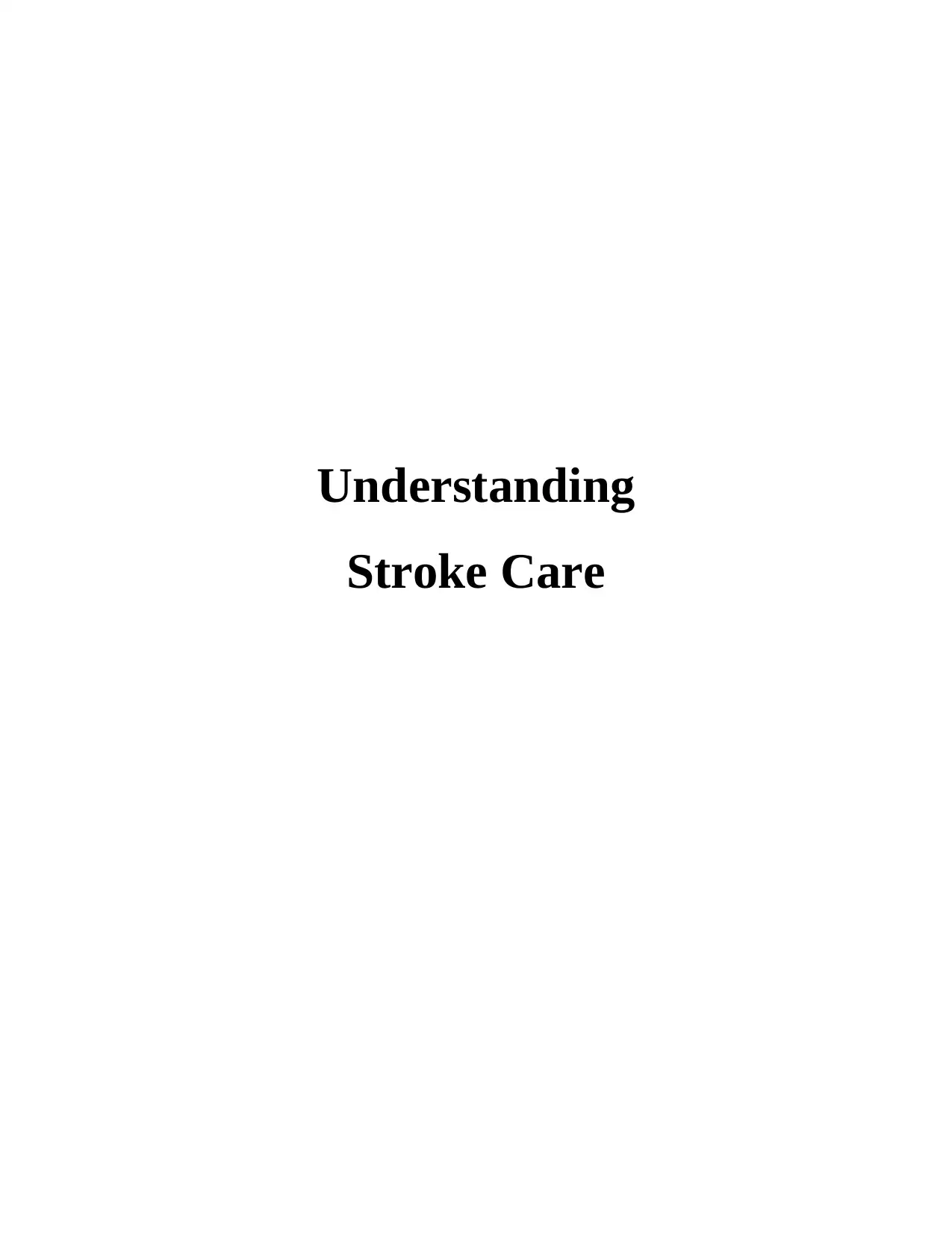
Understanding
Stroke Care
Stroke Care
Secure Best Marks with AI Grader
Need help grading? Try our AI Grader for instant feedback on your assignments.

Table of Contents
INTRODUCTION...........................................................................................................................3
TASK 1............................................................................................................................................3
1.1 Explain various kinds of CVA..............................................................................................3
1.2 Discuss symptoms and signs of left sided and right sided CVA...........................................5
1.3 Reasons for different presentations of signs and symptoms with regard to physiology of
brain.............................................................................................................................................5
TASK 2............................................................................................................................................7
2.1 Risk factors associated with a CVA and preventive health measures...................................7
2.2 Compare and contrast the available investigations linked with diagnosis of CVA..............8
TASK 3..........................................................................................................................................10
3.1 Describe acute and long term care post CVA.....................................................................10
3.2 Roles and interventions of the rehabilitation team..............................................................10
3.3 Effectiveness of care in a specialised stroke unit................................................................12
CONCLUSION..............................................................................................................................12
REFERENCES..............................................................................................................................13
INTRODUCTION...........................................................................................................................3
TASK 1............................................................................................................................................3
1.1 Explain various kinds of CVA..............................................................................................3
1.2 Discuss symptoms and signs of left sided and right sided CVA...........................................5
1.3 Reasons for different presentations of signs and symptoms with regard to physiology of
brain.............................................................................................................................................5
TASK 2............................................................................................................................................7
2.1 Risk factors associated with a CVA and preventive health measures...................................7
2.2 Compare and contrast the available investigations linked with diagnosis of CVA..............8
TASK 3..........................................................................................................................................10
3.1 Describe acute and long term care post CVA.....................................................................10
3.2 Roles and interventions of the rehabilitation team..............................................................10
3.3 Effectiveness of care in a specialised stroke unit................................................................12
CONCLUSION..............................................................................................................................12
REFERENCES..............................................................................................................................13

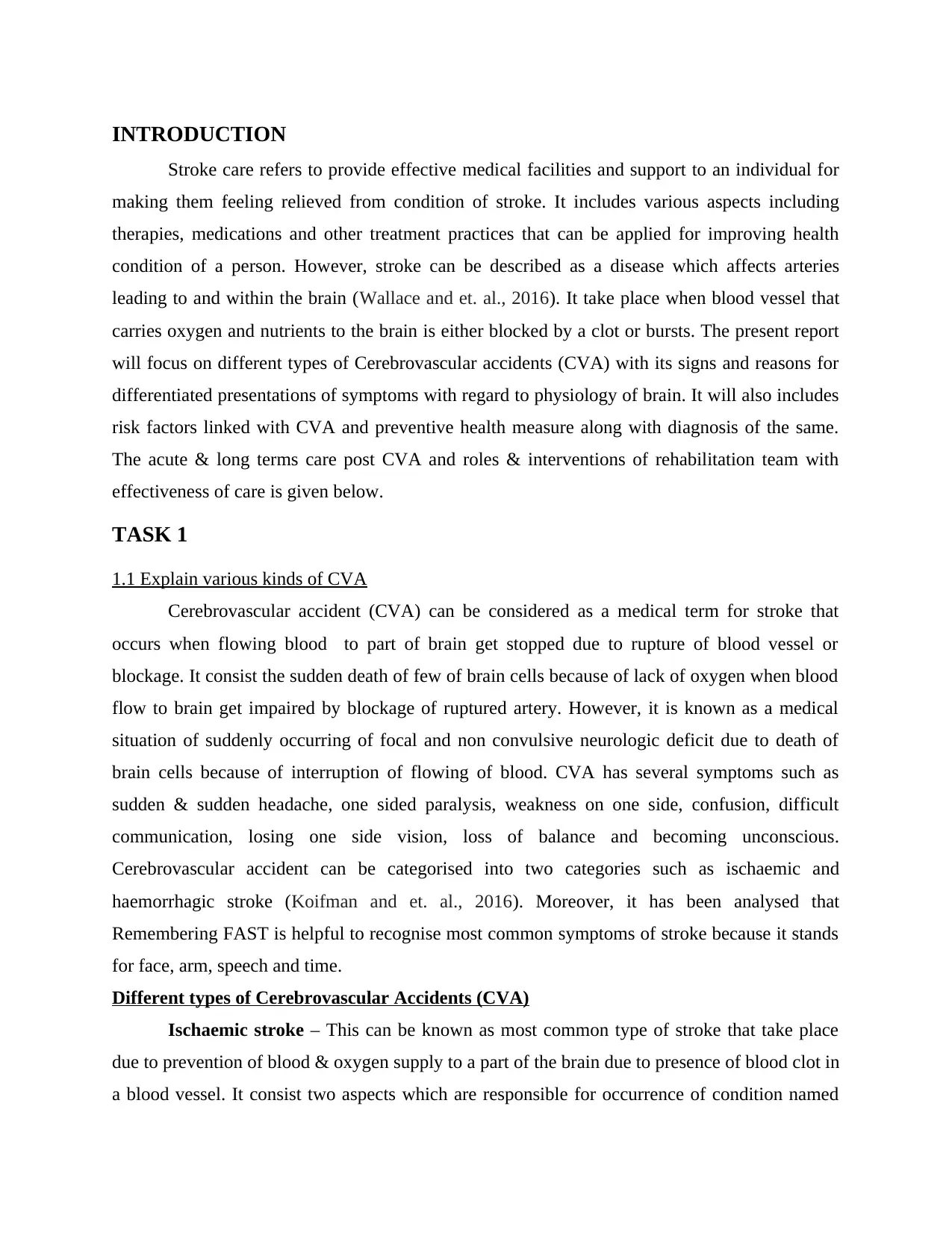
INTRODUCTION
Stroke care refers to provide effective medical facilities and support to an individual for
making them feeling relieved from condition of stroke. It includes various aspects including
therapies, medications and other treatment practices that can be applied for improving health
condition of a person. However, stroke can be described as a disease which affects arteries
leading to and within the brain (Wallace and et. al., 2016). It take place when blood vessel that
carries oxygen and nutrients to the brain is either blocked by a clot or bursts. The present report
will focus on different types of Cerebrovascular accidents (CVA) with its signs and reasons for
differentiated presentations of symptoms with regard to physiology of brain. It will also includes
risk factors linked with CVA and preventive health measure along with diagnosis of the same.
The acute & long terms care post CVA and roles & interventions of rehabilitation team with
effectiveness of care is given below.
TASK 1
1.1 Explain various kinds of CVA
Cerebrovascular accident (CVA) can be considered as a medical term for stroke that
occurs when flowing blood to part of brain get stopped due to rupture of blood vessel or
blockage. It consist the sudden death of few of brain cells because of lack of oxygen when blood
flow to brain get impaired by blockage of ruptured artery. However, it is known as a medical
situation of suddenly occurring of focal and non convulsive neurologic deficit due to death of
brain cells because of interruption of flowing of blood. CVA has several symptoms such as
sudden & sudden headache, one sided paralysis, weakness on one side, confusion, difficult
communication, losing one side vision, loss of balance and becoming unconscious.
Cerebrovascular accident can be categorised into two categories such as ischaemic and
haemorrhagic stroke (Koifman and et. al., 2016). Moreover, it has been analysed that
Remembering FAST is helpful to recognise most common symptoms of stroke because it stands
for face, arm, speech and time.
Different types of Cerebrovascular Accidents (CVA)
Ischaemic stroke – This can be known as most common type of stroke that take place
due to prevention of blood & oxygen supply to a part of the brain due to presence of blood clot in
a blood vessel. It consist two aspects which are responsible for occurrence of condition named
Stroke care refers to provide effective medical facilities and support to an individual for
making them feeling relieved from condition of stroke. It includes various aspects including
therapies, medications and other treatment practices that can be applied for improving health
condition of a person. However, stroke can be described as a disease which affects arteries
leading to and within the brain (Wallace and et. al., 2016). It take place when blood vessel that
carries oxygen and nutrients to the brain is either blocked by a clot or bursts. The present report
will focus on different types of Cerebrovascular accidents (CVA) with its signs and reasons for
differentiated presentations of symptoms with regard to physiology of brain. It will also includes
risk factors linked with CVA and preventive health measure along with diagnosis of the same.
The acute & long terms care post CVA and roles & interventions of rehabilitation team with
effectiveness of care is given below.
TASK 1
1.1 Explain various kinds of CVA
Cerebrovascular accident (CVA) can be considered as a medical term for stroke that
occurs when flowing blood to part of brain get stopped due to rupture of blood vessel or
blockage. It consist the sudden death of few of brain cells because of lack of oxygen when blood
flow to brain get impaired by blockage of ruptured artery. However, it is known as a medical
situation of suddenly occurring of focal and non convulsive neurologic deficit due to death of
brain cells because of interruption of flowing of blood. CVA has several symptoms such as
sudden & sudden headache, one sided paralysis, weakness on one side, confusion, difficult
communication, losing one side vision, loss of balance and becoming unconscious.
Cerebrovascular accident can be categorised into two categories such as ischaemic and
haemorrhagic stroke (Koifman and et. al., 2016). Moreover, it has been analysed that
Remembering FAST is helpful to recognise most common symptoms of stroke because it stands
for face, arm, speech and time.
Different types of Cerebrovascular Accidents (CVA)
Ischaemic stroke – This can be known as most common type of stroke that take place
due to prevention of blood & oxygen supply to a part of the brain due to presence of blood clot in
a blood vessel. It consist two aspects which are responsible for occurrence of condition named
Secure Best Marks with AI Grader
Need help grading? Try our AI Grader for instant feedback on your assignments.
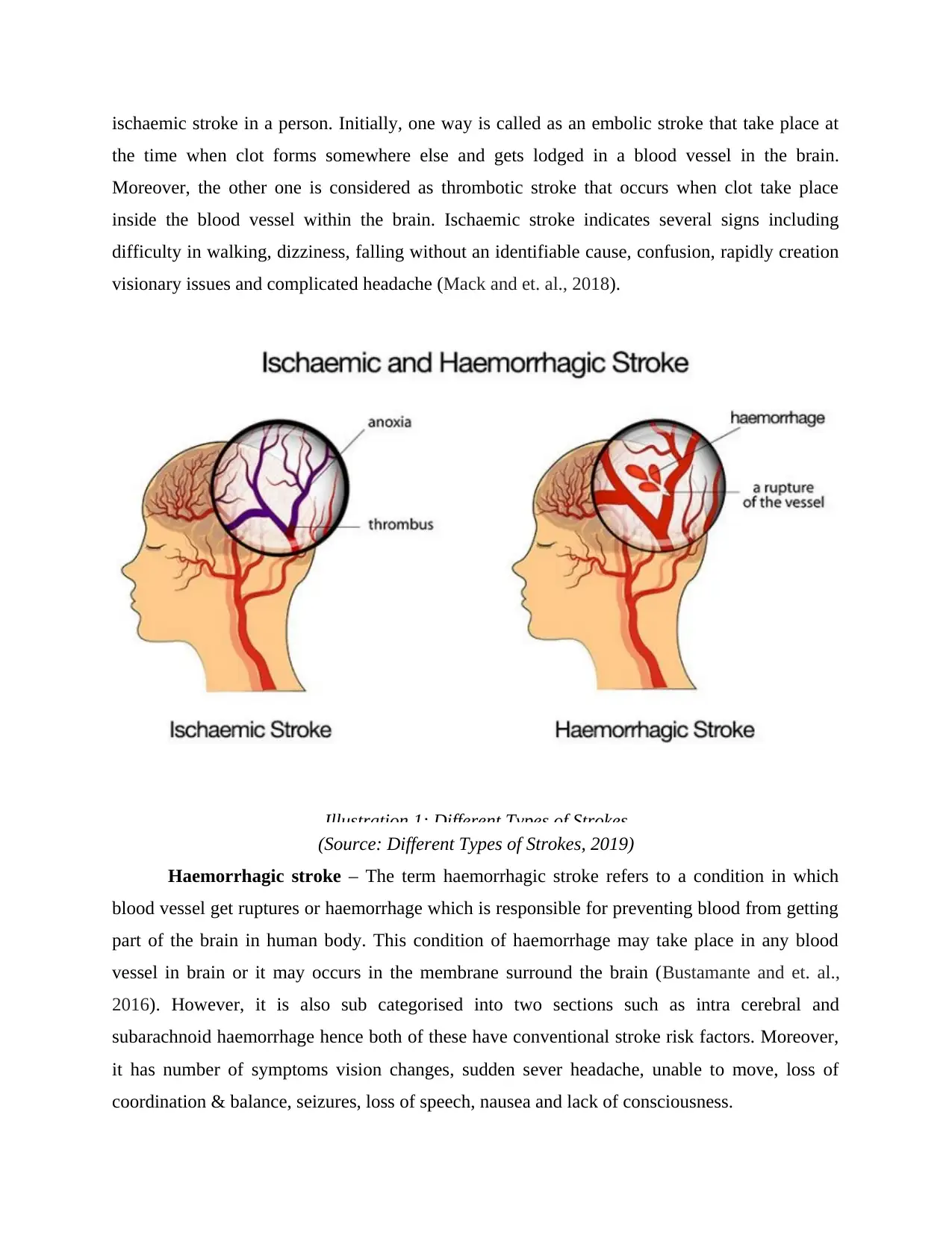
ischaemic stroke in a person. Initially, one way is called as an embolic stroke that take place at
the time when clot forms somewhere else and gets lodged in a blood vessel in the brain.
Moreover, the other one is considered as thrombotic stroke that occurs when clot take place
inside the blood vessel within the brain. Ischaemic stroke indicates several signs including
difficulty in walking, dizziness, falling without an identifiable cause, confusion, rapidly creation
visionary issues and complicated headache (Mack and et. al., 2018).
(Source: Different Types of Strokes, 2019)
Haemorrhagic stroke – The term haemorrhagic stroke refers to a condition in which
blood vessel get ruptures or haemorrhage which is responsible for preventing blood from getting
part of the brain in human body. This condition of haemorrhage may take place in any blood
vessel in brain or it may occurs in the membrane surround the brain (Bustamante and et. al.,
2016). However, it is also sub categorised into two sections such as intra cerebral and
subarachnoid haemorrhage hence both of these have conventional stroke risk factors. Moreover,
it has number of symptoms vision changes, sudden sever headache, unable to move, loss of
coordination & balance, seizures, loss of speech, nausea and lack of consciousness.
Illustration 1: Different Types of Strokes
the time when clot forms somewhere else and gets lodged in a blood vessel in the brain.
Moreover, the other one is considered as thrombotic stroke that occurs when clot take place
inside the blood vessel within the brain. Ischaemic stroke indicates several signs including
difficulty in walking, dizziness, falling without an identifiable cause, confusion, rapidly creation
visionary issues and complicated headache (Mack and et. al., 2018).
(Source: Different Types of Strokes, 2019)
Haemorrhagic stroke – The term haemorrhagic stroke refers to a condition in which
blood vessel get ruptures or haemorrhage which is responsible for preventing blood from getting
part of the brain in human body. This condition of haemorrhage may take place in any blood
vessel in brain or it may occurs in the membrane surround the brain (Bustamante and et. al.,
2016). However, it is also sub categorised into two sections such as intra cerebral and
subarachnoid haemorrhage hence both of these have conventional stroke risk factors. Moreover,
it has number of symptoms vision changes, sudden sever headache, unable to move, loss of
coordination & balance, seizures, loss of speech, nausea and lack of consciousness.
Illustration 1: Different Types of Strokes
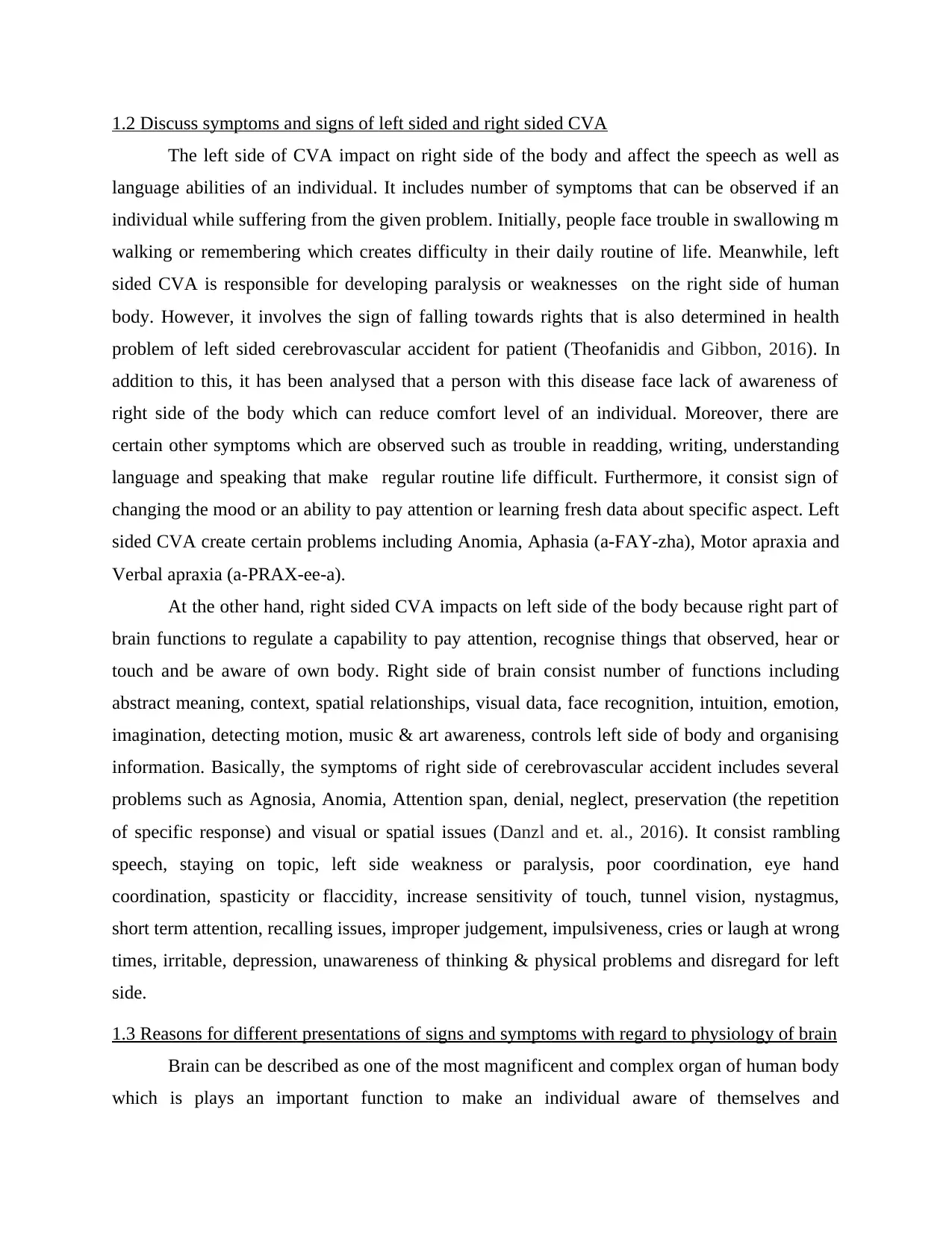
1.2 Discuss symptoms and signs of left sided and right sided CVA
The left side of CVA impact on right side of the body and affect the speech as well as
language abilities of an individual. It includes number of symptoms that can be observed if an
individual while suffering from the given problem. Initially, people face trouble in swallowing m
walking or remembering which creates difficulty in their daily routine of life. Meanwhile, left
sided CVA is responsible for developing paralysis or weaknesses on the right side of human
body. However, it involves the sign of falling towards rights that is also determined in health
problem of left sided cerebrovascular accident for patient (Theofanidis and Gibbon, 2016). In
addition to this, it has been analysed that a person with this disease face lack of awareness of
right side of the body which can reduce comfort level of an individual. Moreover, there are
certain other symptoms which are observed such as trouble in readding, writing, understanding
language and speaking that make regular routine life difficult. Furthermore, it consist sign of
changing the mood or an ability to pay attention or learning fresh data about specific aspect. Left
sided CVA create certain problems including Anomia, Aphasia (a-FAY-zha), Motor apraxia and
Verbal apraxia (a-PRAX-ee-a).
At the other hand, right sided CVA impacts on left side of the body because right part of
brain functions to regulate a capability to pay attention, recognise things that observed, hear or
touch and be aware of own body. Right side of brain consist number of functions including
abstract meaning, context, spatial relationships, visual data, face recognition, intuition, emotion,
imagination, detecting motion, music & art awareness, controls left side of body and organising
information. Basically, the symptoms of right side of cerebrovascular accident includes several
problems such as Agnosia, Anomia, Attention span, denial, neglect, preservation (the repetition
of specific response) and visual or spatial issues (Danzl and et. al., 2016). It consist rambling
speech, staying on topic, left side weakness or paralysis, poor coordination, eye hand
coordination, spasticity or flaccidity, increase sensitivity of touch, tunnel vision, nystagmus,
short term attention, recalling issues, improper judgement, impulsiveness, cries or laugh at wrong
times, irritable, depression, unawareness of thinking & physical problems and disregard for left
side.
1.3 Reasons for different presentations of signs and symptoms with regard to physiology of brain
Brain can be described as one of the most magnificent and complex organ of human body
which is plays an important function to make an individual aware of themselves and
The left side of CVA impact on right side of the body and affect the speech as well as
language abilities of an individual. It includes number of symptoms that can be observed if an
individual while suffering from the given problem. Initially, people face trouble in swallowing m
walking or remembering which creates difficulty in their daily routine of life. Meanwhile, left
sided CVA is responsible for developing paralysis or weaknesses on the right side of human
body. However, it involves the sign of falling towards rights that is also determined in health
problem of left sided cerebrovascular accident for patient (Theofanidis and Gibbon, 2016). In
addition to this, it has been analysed that a person with this disease face lack of awareness of
right side of the body which can reduce comfort level of an individual. Moreover, there are
certain other symptoms which are observed such as trouble in readding, writing, understanding
language and speaking that make regular routine life difficult. Furthermore, it consist sign of
changing the mood or an ability to pay attention or learning fresh data about specific aspect. Left
sided CVA create certain problems including Anomia, Aphasia (a-FAY-zha), Motor apraxia and
Verbal apraxia (a-PRAX-ee-a).
At the other hand, right sided CVA impacts on left side of the body because right part of
brain functions to regulate a capability to pay attention, recognise things that observed, hear or
touch and be aware of own body. Right side of brain consist number of functions including
abstract meaning, context, spatial relationships, visual data, face recognition, intuition, emotion,
imagination, detecting motion, music & art awareness, controls left side of body and organising
information. Basically, the symptoms of right side of cerebrovascular accident includes several
problems such as Agnosia, Anomia, Attention span, denial, neglect, preservation (the repetition
of specific response) and visual or spatial issues (Danzl and et. al., 2016). It consist rambling
speech, staying on topic, left side weakness or paralysis, poor coordination, eye hand
coordination, spasticity or flaccidity, increase sensitivity of touch, tunnel vision, nystagmus,
short term attention, recalling issues, improper judgement, impulsiveness, cries or laugh at wrong
times, irritable, depression, unawareness of thinking & physical problems and disregard for left
side.
1.3 Reasons for different presentations of signs and symptoms with regard to physiology of brain
Brain can be described as one of the most magnificent and complex organ of human body
which is plays an important function to make an individual aware of themselves and

environment. It has a role to process a constant sensory data and regulate secretions from glands,
breathing, internal body temperature and movements of muscles. However, brain is an important
part which generate different kinds of feeling, planning and creative thoughts. The brain has
neurons which functions to record memory of every life activity or event hence human brain is
known to be very complicated.
Physiology of brain
Brain has three main parts including cerebrum, cerebellum and brain stem having their
own specific roles. Initially, cerebrum is largest part of brain that consist right & left
hemispheres and control functions like hearing, vision, speech, reasoning, emotions, touch and
regulating movement (Sweeney, 2017). However, cerebellum exist under cerebrum which
perform coordination of muscle movements and maintain balance as well as posture. Moreover,
brainstem is connecting link between cerebrum and cerebellum to spinal cord and it has
automatic function including temperature of body, wake & sleep cycles, digestion, sneezing,
coughing, vomiting, swallowing and breathing. Brain consist several other parts like cerebral
cortex, cortex divisions, brain Stem & cerebellum, hippocampus, thalamus and hypothalamus.
Right side of brain
The right side of brain functions to regulate left side of body activities which is the reason
behind different presentations of signs. It includes the fact that occurrence of right sided
cerebrovascular accident (CVA) impacts on left side of the body as it get partially or completely
weak or paralysed. However, right brain has various characteristics such as big picture oriented,
imagination rules, images & symptoms, intuition, appreciated, spatial perception, knows object
function, fantasy based, presents possibilities, impetuous, risk taker, more likely to visualise than
think in words and uses feeling. These features of right side brain get disturbed while occurring
right sided CVA which affects the left part of human body and indicates relevant symptoms of
the selected health issue (Theofanidis and Gibbon, 2016).
Left side of brain
The left part of brain is responsible for regulating functions of left side of human body so
that left sided CVA affects on the left side of the body. It consist various feature to control
respective functions in body including detail oriented, facts rule, words & language, science &
maths, knowing, acknowledges, knows object name, reality based, practical, risk avoidant,
breathing, internal body temperature and movements of muscles. However, brain is an important
part which generate different kinds of feeling, planning and creative thoughts. The brain has
neurons which functions to record memory of every life activity or event hence human brain is
known to be very complicated.
Physiology of brain
Brain has three main parts including cerebrum, cerebellum and brain stem having their
own specific roles. Initially, cerebrum is largest part of brain that consist right & left
hemispheres and control functions like hearing, vision, speech, reasoning, emotions, touch and
regulating movement (Sweeney, 2017). However, cerebellum exist under cerebrum which
perform coordination of muscle movements and maintain balance as well as posture. Moreover,
brainstem is connecting link between cerebrum and cerebellum to spinal cord and it has
automatic function including temperature of body, wake & sleep cycles, digestion, sneezing,
coughing, vomiting, swallowing and breathing. Brain consist several other parts like cerebral
cortex, cortex divisions, brain Stem & cerebellum, hippocampus, thalamus and hypothalamus.
Right side of brain
The right side of brain functions to regulate left side of body activities which is the reason
behind different presentations of signs. It includes the fact that occurrence of right sided
cerebrovascular accident (CVA) impacts on left side of the body as it get partially or completely
weak or paralysed. However, right brain has various characteristics such as big picture oriented,
imagination rules, images & symptoms, intuition, appreciated, spatial perception, knows object
function, fantasy based, presents possibilities, impetuous, risk taker, more likely to visualise than
think in words and uses feeling. These features of right side brain get disturbed while occurring
right sided CVA which affects the left part of human body and indicates relevant symptoms of
the selected health issue (Theofanidis and Gibbon, 2016).
Left side of brain
The left part of brain is responsible for regulating functions of left side of human body so
that left sided CVA affects on the left side of the body. It consist various feature to control
respective functions in body including detail oriented, facts rule, words & language, science &
maths, knowing, acknowledges, knows object name, reality based, practical, risk avoidant,
Paraphrase This Document
Need a fresh take? Get an instant paraphrase of this document with our AI Paraphraser
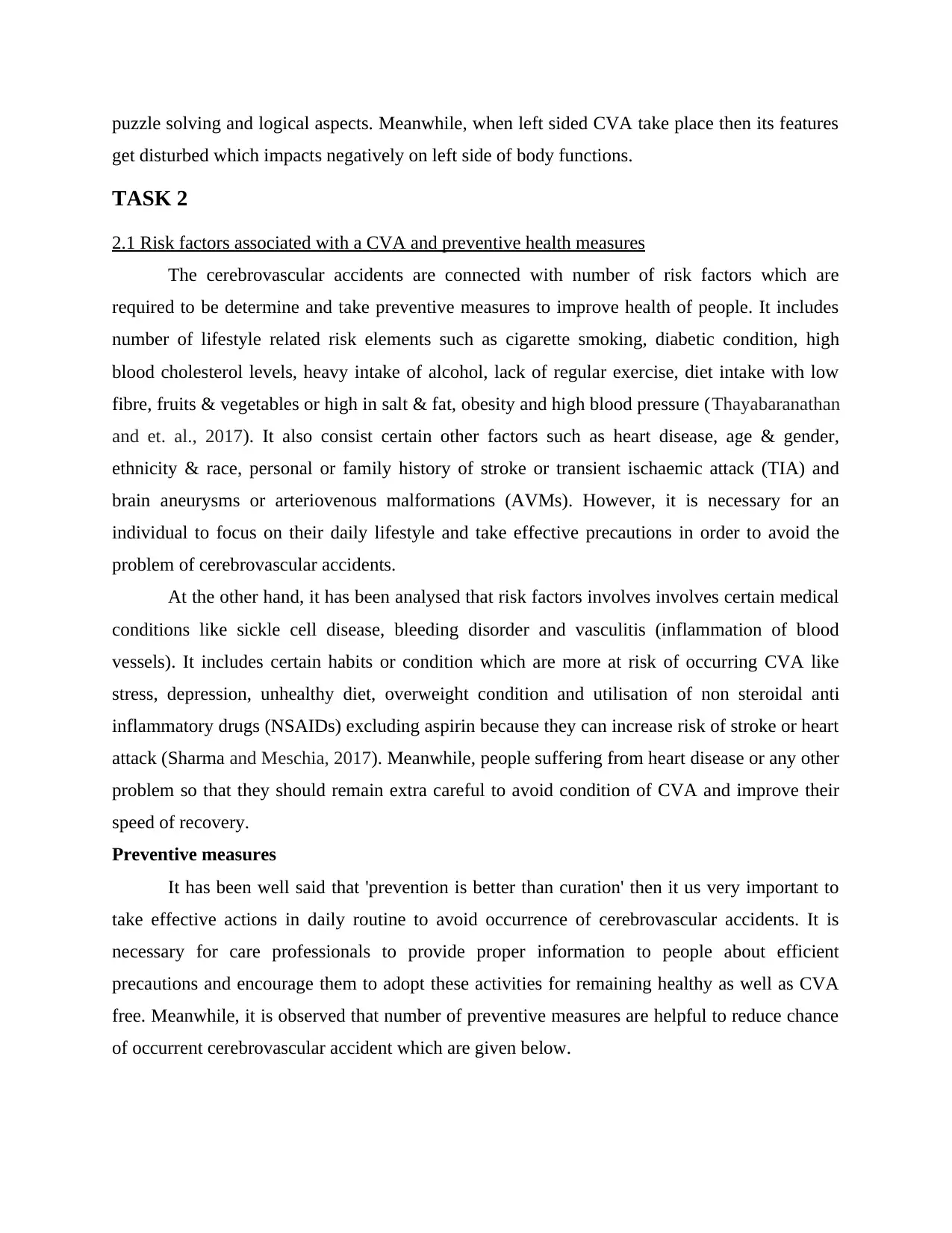
puzzle solving and logical aspects. Meanwhile, when left sided CVA take place then its features
get disturbed which impacts negatively on left side of body functions.
TASK 2
2.1 Risk factors associated with a CVA and preventive health measures
The cerebrovascular accidents are connected with number of risk factors which are
required to be determine and take preventive measures to improve health of people. It includes
number of lifestyle related risk elements such as cigarette smoking, diabetic condition, high
blood cholesterol levels, heavy intake of alcohol, lack of regular exercise, diet intake with low
fibre, fruits & vegetables or high in salt & fat, obesity and high blood pressure (Thayabaranathan
and et. al., 2017). It also consist certain other factors such as heart disease, age & gender,
ethnicity & race, personal or family history of stroke or transient ischaemic attack (TIA) and
brain aneurysms or arteriovenous malformations (AVMs). However, it is necessary for an
individual to focus on their daily lifestyle and take effective precautions in order to avoid the
problem of cerebrovascular accidents.
At the other hand, it has been analysed that risk factors involves involves certain medical
conditions like sickle cell disease, bleeding disorder and vasculitis (inflammation of blood
vessels). It includes certain habits or condition which are more at risk of occurring CVA like
stress, depression, unhealthy diet, overweight condition and utilisation of non steroidal anti
inflammatory drugs (NSAIDs) excluding aspirin because they can increase risk of stroke or heart
attack (Sharma and Meschia, 2017). Meanwhile, people suffering from heart disease or any other
problem so that they should remain extra careful to avoid condition of CVA and improve their
speed of recovery.
Preventive measures
It has been well said that 'prevention is better than curation' then it us very important to
take effective actions in daily routine to avoid occurrence of cerebrovascular accidents. It is
necessary for care professionals to provide proper information to people about efficient
precautions and encourage them to adopt these activities for remaining healthy as well as CVA
free. Meanwhile, it is observed that number of preventive measures are helpful to reduce chance
of occurrent cerebrovascular accident which are given below.
get disturbed which impacts negatively on left side of body functions.
TASK 2
2.1 Risk factors associated with a CVA and preventive health measures
The cerebrovascular accidents are connected with number of risk factors which are
required to be determine and take preventive measures to improve health of people. It includes
number of lifestyle related risk elements such as cigarette smoking, diabetic condition, high
blood cholesterol levels, heavy intake of alcohol, lack of regular exercise, diet intake with low
fibre, fruits & vegetables or high in salt & fat, obesity and high blood pressure (Thayabaranathan
and et. al., 2017). It also consist certain other factors such as heart disease, age & gender,
ethnicity & race, personal or family history of stroke or transient ischaemic attack (TIA) and
brain aneurysms or arteriovenous malformations (AVMs). However, it is necessary for an
individual to focus on their daily lifestyle and take effective precautions in order to avoid the
problem of cerebrovascular accidents.
At the other hand, it has been analysed that risk factors involves involves certain medical
conditions like sickle cell disease, bleeding disorder and vasculitis (inflammation of blood
vessels). It includes certain habits or condition which are more at risk of occurring CVA like
stress, depression, unhealthy diet, overweight condition and utilisation of non steroidal anti
inflammatory drugs (NSAIDs) excluding aspirin because they can increase risk of stroke or heart
attack (Sharma and Meschia, 2017). Meanwhile, people suffering from heart disease or any other
problem so that they should remain extra careful to avoid condition of CVA and improve their
speed of recovery.
Preventive measures
It has been well said that 'prevention is better than curation' then it us very important to
take effective actions in daily routine to avoid occurrence of cerebrovascular accidents. It is
necessary for care professionals to provide proper information to people about efficient
precautions and encourage them to adopt these activities for remaining healthy as well as CVA
free. Meanwhile, it is observed that number of preventive measures are helpful to reduce chance
of occurrent cerebrovascular accident which are given below.
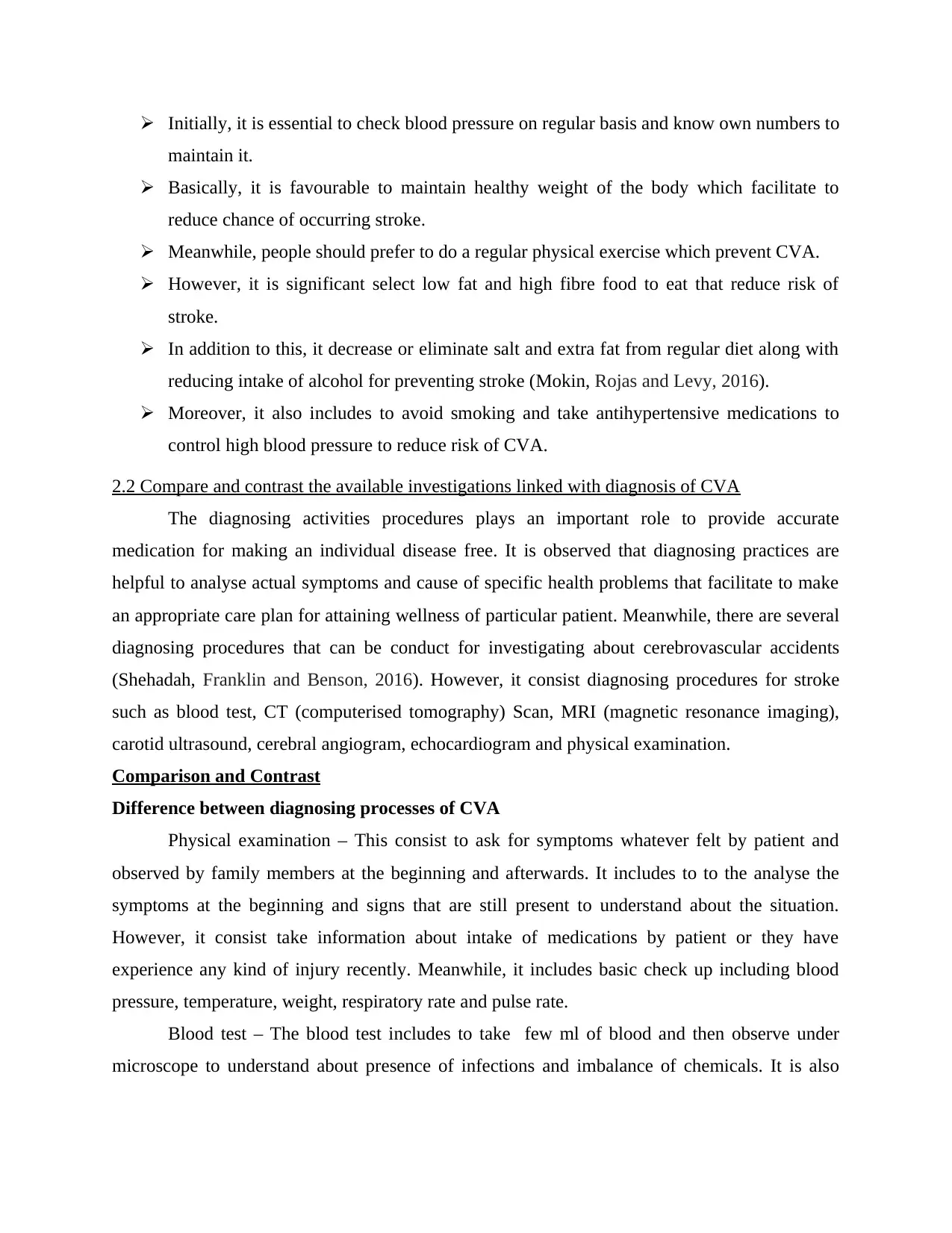
Initially, it is essential to check blood pressure on regular basis and know own numbers to
maintain it.
Basically, it is favourable to maintain healthy weight of the body which facilitate to
reduce chance of occurring stroke.
Meanwhile, people should prefer to do a regular physical exercise which prevent CVA.
However, it is significant select low fat and high fibre food to eat that reduce risk of
stroke.
In addition to this, it decrease or eliminate salt and extra fat from regular diet along with
reducing intake of alcohol for preventing stroke (Mokin, Rojas and Levy, 2016).
Moreover, it also includes to avoid smoking and take antihypertensive medications to
control high blood pressure to reduce risk of CVA.
2.2 Compare and contrast the available investigations linked with diagnosis of CVA
The diagnosing activities procedures plays an important role to provide accurate
medication for making an individual disease free. It is observed that diagnosing practices are
helpful to analyse actual symptoms and cause of specific health problems that facilitate to make
an appropriate care plan for attaining wellness of particular patient. Meanwhile, there are several
diagnosing procedures that can be conduct for investigating about cerebrovascular accidents
(Shehadah, Franklin and Benson, 2016). However, it consist diagnosing procedures for stroke
such as blood test, CT (computerised tomography) Scan, MRI (magnetic resonance imaging),
carotid ultrasound, cerebral angiogram, echocardiogram and physical examination.
Comparison and Contrast
Difference between diagnosing processes of CVA
Physical examination – This consist to ask for symptoms whatever felt by patient and
observed by family members at the beginning and afterwards. It includes to to the analyse the
symptoms at the beginning and signs that are still present to understand about the situation.
However, it consist take information about intake of medications by patient or they have
experience any kind of injury recently. Meanwhile, it includes basic check up including blood
pressure, temperature, weight, respiratory rate and pulse rate.
Blood test – The blood test includes to take few ml of blood and then observe under
microscope to understand about presence of infections and imbalance of chemicals. It is also
maintain it.
Basically, it is favourable to maintain healthy weight of the body which facilitate to
reduce chance of occurring stroke.
Meanwhile, people should prefer to do a regular physical exercise which prevent CVA.
However, it is significant select low fat and high fibre food to eat that reduce risk of
stroke.
In addition to this, it decrease or eliminate salt and extra fat from regular diet along with
reducing intake of alcohol for preventing stroke (Mokin, Rojas and Levy, 2016).
Moreover, it also includes to avoid smoking and take antihypertensive medications to
control high blood pressure to reduce risk of CVA.
2.2 Compare and contrast the available investigations linked with diagnosis of CVA
The diagnosing activities procedures plays an important role to provide accurate
medication for making an individual disease free. It is observed that diagnosing practices are
helpful to analyse actual symptoms and cause of specific health problems that facilitate to make
an appropriate care plan for attaining wellness of particular patient. Meanwhile, there are several
diagnosing procedures that can be conduct for investigating about cerebrovascular accidents
(Shehadah, Franklin and Benson, 2016). However, it consist diagnosing procedures for stroke
such as blood test, CT (computerised tomography) Scan, MRI (magnetic resonance imaging),
carotid ultrasound, cerebral angiogram, echocardiogram and physical examination.
Comparison and Contrast
Difference between diagnosing processes of CVA
Physical examination – This consist to ask for symptoms whatever felt by patient and
observed by family members at the beginning and afterwards. It includes to to the analyse the
symptoms at the beginning and signs that are still present to understand about the situation.
However, it consist take information about intake of medications by patient or they have
experience any kind of injury recently. Meanwhile, it includes basic check up including blood
pressure, temperature, weight, respiratory rate and pulse rate.
Blood test – The blood test includes to take few ml of blood and then observe under
microscope to understand about presence of infections and imbalance of chemicals. It is also
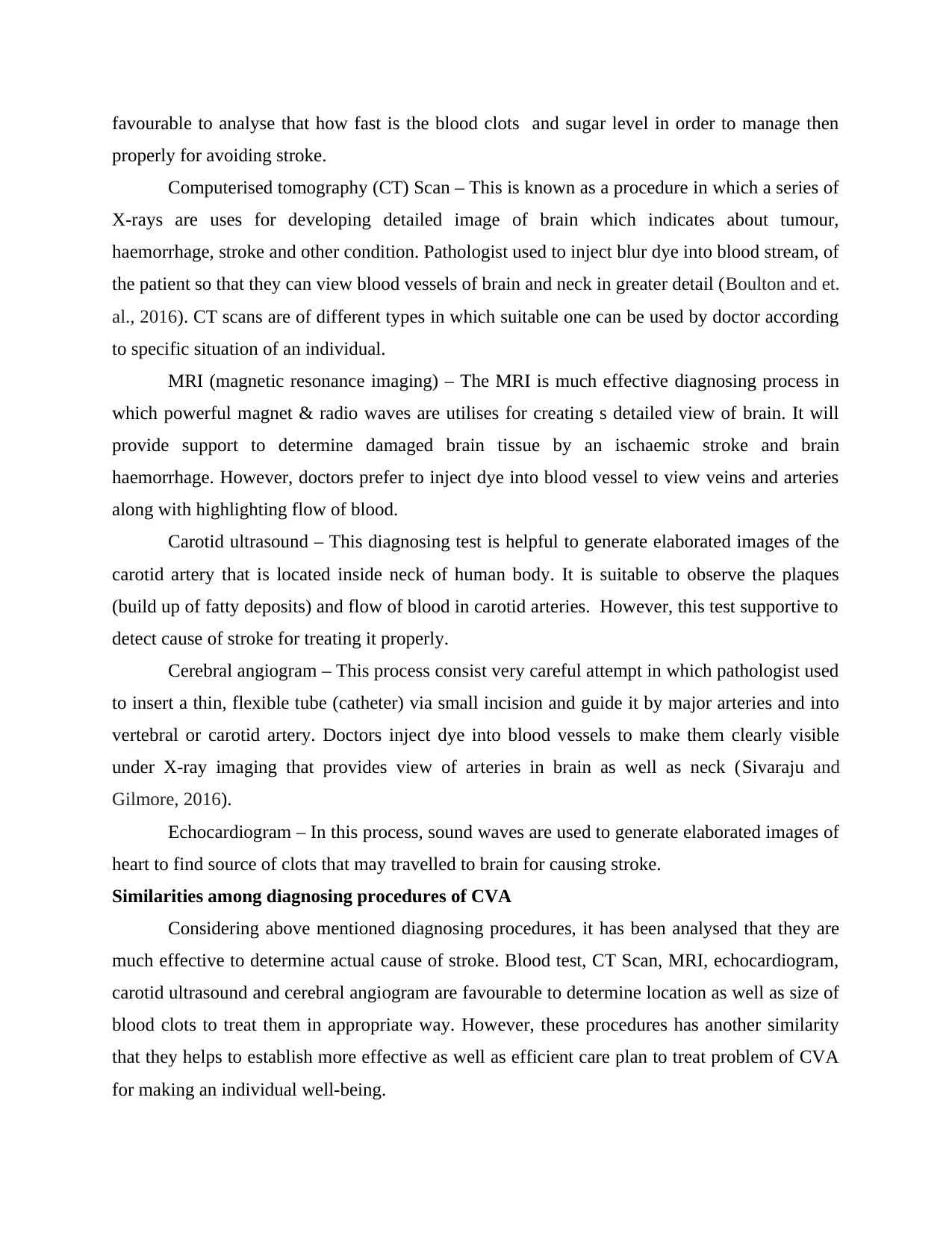
favourable to analyse that how fast is the blood clots and sugar level in order to manage then
properly for avoiding stroke.
Computerised tomography (CT) Scan – This is known as a procedure in which a series of
X-rays are uses for developing detailed image of brain which indicates about tumour,
haemorrhage, stroke and other condition. Pathologist used to inject blur dye into blood stream, of
the patient so that they can view blood vessels of brain and neck in greater detail (Boulton and et.
al., 2016). CT scans are of different types in which suitable one can be used by doctor according
to specific situation of an individual.
MRI (magnetic resonance imaging) – The MRI is much effective diagnosing process in
which powerful magnet & radio waves are utilises for creating s detailed view of brain. It will
provide support to determine damaged brain tissue by an ischaemic stroke and brain
haemorrhage. However, doctors prefer to inject dye into blood vessel to view veins and arteries
along with highlighting flow of blood.
Carotid ultrasound – This diagnosing test is helpful to generate elaborated images of the
carotid artery that is located inside neck of human body. It is suitable to observe the plaques
(build up of fatty deposits) and flow of blood in carotid arteries. However, this test supportive to
detect cause of stroke for treating it properly.
Cerebral angiogram – This process consist very careful attempt in which pathologist used
to insert a thin, flexible tube (catheter) via small incision and guide it by major arteries and into
vertebral or carotid artery. Doctors inject dye into blood vessels to make them clearly visible
under X-ray imaging that provides view of arteries in brain as well as neck (Sivaraju and
Gilmore, 2016).
Echocardiogram – In this process, sound waves are used to generate elaborated images of
heart to find source of clots that may travelled to brain for causing stroke.
Similarities among diagnosing procedures of CVA
Considering above mentioned diagnosing procedures, it has been analysed that they are
much effective to determine actual cause of stroke. Blood test, CT Scan, MRI, echocardiogram,
carotid ultrasound and cerebral angiogram are favourable to determine location as well as size of
blood clots to treat them in appropriate way. However, these procedures has another similarity
that they helps to establish more effective as well as efficient care plan to treat problem of CVA
for making an individual well-being.
properly for avoiding stroke.
Computerised tomography (CT) Scan – This is known as a procedure in which a series of
X-rays are uses for developing detailed image of brain which indicates about tumour,
haemorrhage, stroke and other condition. Pathologist used to inject blur dye into blood stream, of
the patient so that they can view blood vessels of brain and neck in greater detail (Boulton and et.
al., 2016). CT scans are of different types in which suitable one can be used by doctor according
to specific situation of an individual.
MRI (magnetic resonance imaging) – The MRI is much effective diagnosing process in
which powerful magnet & radio waves are utilises for creating s detailed view of brain. It will
provide support to determine damaged brain tissue by an ischaemic stroke and brain
haemorrhage. However, doctors prefer to inject dye into blood vessel to view veins and arteries
along with highlighting flow of blood.
Carotid ultrasound – This diagnosing test is helpful to generate elaborated images of the
carotid artery that is located inside neck of human body. It is suitable to observe the plaques
(build up of fatty deposits) and flow of blood in carotid arteries. However, this test supportive to
detect cause of stroke for treating it properly.
Cerebral angiogram – This process consist very careful attempt in which pathologist used
to insert a thin, flexible tube (catheter) via small incision and guide it by major arteries and into
vertebral or carotid artery. Doctors inject dye into blood vessels to make them clearly visible
under X-ray imaging that provides view of arteries in brain as well as neck (Sivaraju and
Gilmore, 2016).
Echocardiogram – In this process, sound waves are used to generate elaborated images of
heart to find source of clots that may travelled to brain for causing stroke.
Similarities among diagnosing procedures of CVA
Considering above mentioned diagnosing procedures, it has been analysed that they are
much effective to determine actual cause of stroke. Blood test, CT Scan, MRI, echocardiogram,
carotid ultrasound and cerebral angiogram are favourable to determine location as well as size of
blood clots to treat them in appropriate way. However, these procedures has another similarity
that they helps to establish more effective as well as efficient care plan to treat problem of CVA
for making an individual well-being.
Secure Best Marks with AI Grader
Need help grading? Try our AI Grader for instant feedback on your assignments.
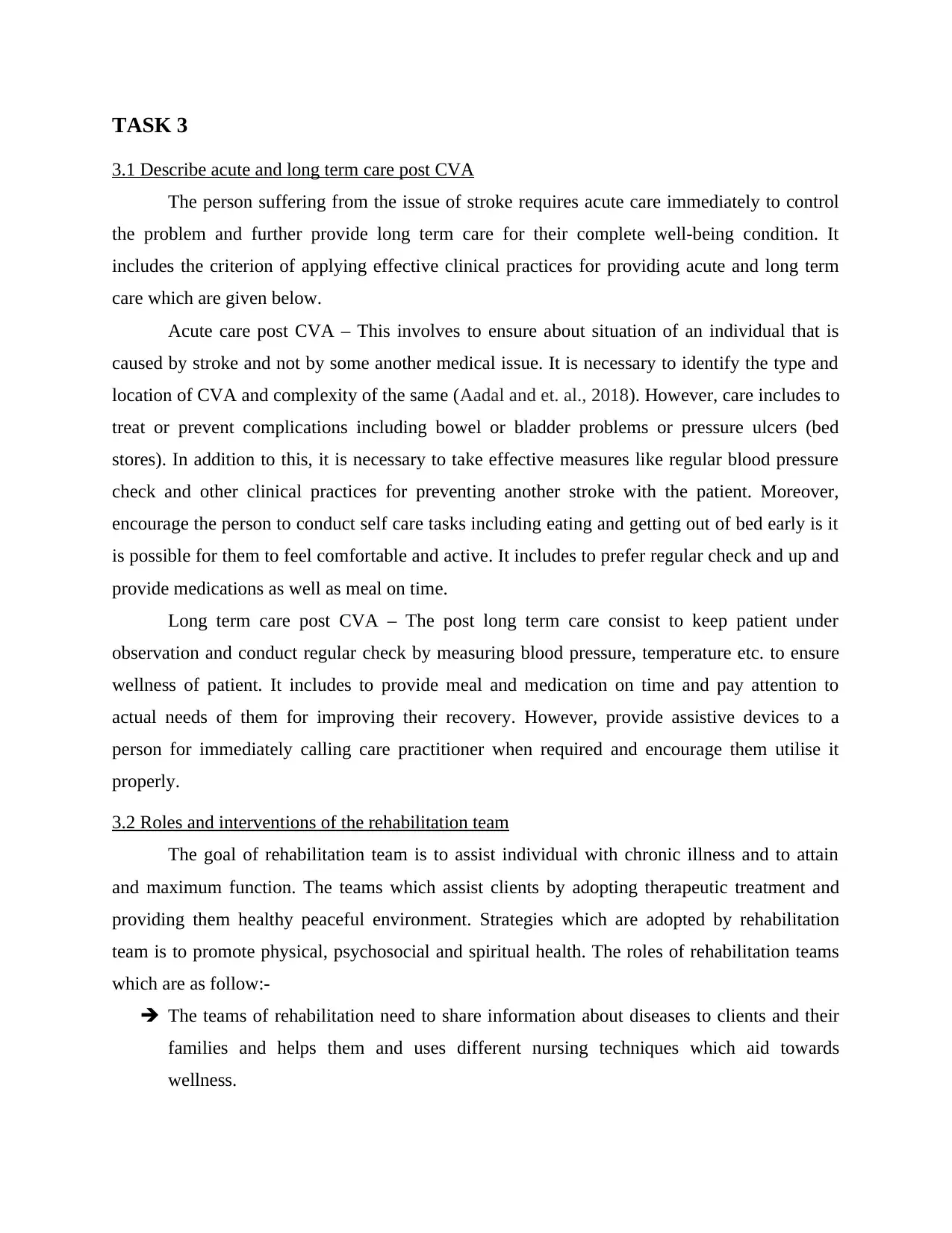
TASK 3
3.1 Describe acute and long term care post CVA
The person suffering from the issue of stroke requires acute care immediately to control
the problem and further provide long term care for their complete well-being condition. It
includes the criterion of applying effective clinical practices for providing acute and long term
care which are given below.
Acute care post CVA – This involves to ensure about situation of an individual that is
caused by stroke and not by some another medical issue. It is necessary to identify the type and
location of CVA and complexity of the same (Aadal and et. al., 2018). However, care includes to
treat or prevent complications including bowel or bladder problems or pressure ulcers (bed
stores). In addition to this, it is necessary to take effective measures like regular blood pressure
check and other clinical practices for preventing another stroke with the patient. Moreover,
encourage the person to conduct self care tasks including eating and getting out of bed early is it
is possible for them to feel comfortable and active. It includes to prefer regular check and up and
provide medications as well as meal on time.
Long term care post CVA – The post long term care consist to keep patient under
observation and conduct regular check by measuring blood pressure, temperature etc. to ensure
wellness of patient. It includes to provide meal and medication on time and pay attention to
actual needs of them for improving their recovery. However, provide assistive devices to a
person for immediately calling care practitioner when required and encourage them utilise it
properly.
3.2 Roles and interventions of the rehabilitation team
The goal of rehabilitation team is to assist individual with chronic illness and to attain
and maximum function. The teams which assist clients by adopting therapeutic treatment and
providing them healthy peaceful environment. Strategies which are adopted by rehabilitation
team is to promote physical, psychosocial and spiritual health. The roles of rehabilitation teams
which are as follow:-
The teams of rehabilitation need to share information about diseases to clients and their
families and helps them and uses different nursing techniques which aid towards
wellness.
3.1 Describe acute and long term care post CVA
The person suffering from the issue of stroke requires acute care immediately to control
the problem and further provide long term care for their complete well-being condition. It
includes the criterion of applying effective clinical practices for providing acute and long term
care which are given below.
Acute care post CVA – This involves to ensure about situation of an individual that is
caused by stroke and not by some another medical issue. It is necessary to identify the type and
location of CVA and complexity of the same (Aadal and et. al., 2018). However, care includes to
treat or prevent complications including bowel or bladder problems or pressure ulcers (bed
stores). In addition to this, it is necessary to take effective measures like regular blood pressure
check and other clinical practices for preventing another stroke with the patient. Moreover,
encourage the person to conduct self care tasks including eating and getting out of bed early is it
is possible for them to feel comfortable and active. It includes to prefer regular check and up and
provide medications as well as meal on time.
Long term care post CVA – The post long term care consist to keep patient under
observation and conduct regular check by measuring blood pressure, temperature etc. to ensure
wellness of patient. It includes to provide meal and medication on time and pay attention to
actual needs of them for improving their recovery. However, provide assistive devices to a
person for immediately calling care practitioner when required and encourage them utilise it
properly.
3.2 Roles and interventions of the rehabilitation team
The goal of rehabilitation team is to assist individual with chronic illness and to attain
and maximum function. The teams which assist clients by adopting therapeutic treatment and
providing them healthy peaceful environment. Strategies which are adopted by rehabilitation
team is to promote physical, psychosocial and spiritual health. The roles of rehabilitation teams
which are as follow:-
The teams of rehabilitation need to share information about diseases to clients and their
families and helps them and uses different nursing techniques which aid towards
wellness.
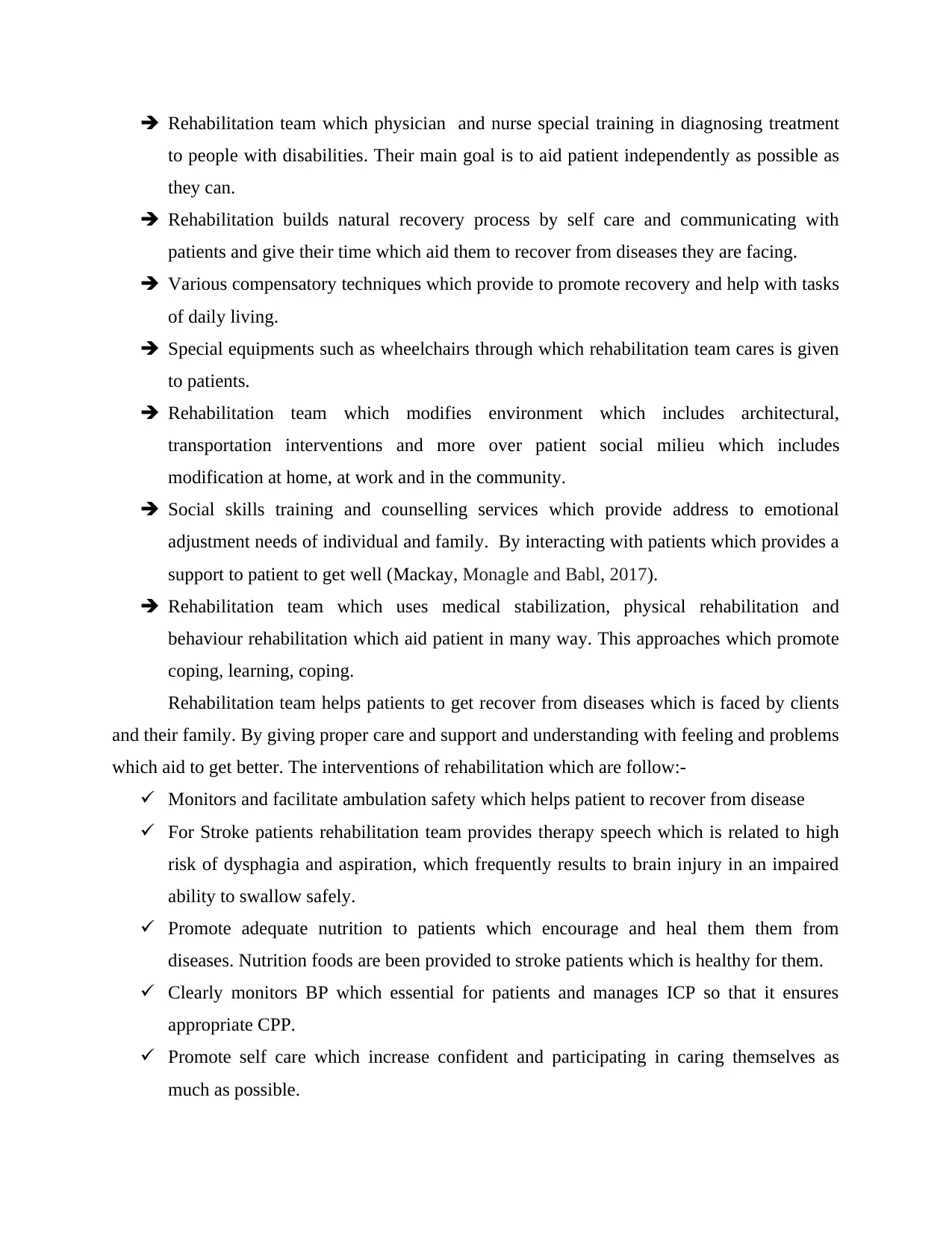
Rehabilitation team which physician and nurse special training in diagnosing treatment
to people with disabilities. Their main goal is to aid patient independently as possible as
they can.
Rehabilitation builds natural recovery process by self care and communicating with
patients and give their time which aid them to recover from diseases they are facing.
Various compensatory techniques which provide to promote recovery and help with tasks
of daily living.
Special equipments such as wheelchairs through which rehabilitation team cares is given
to patients.
Rehabilitation team which modifies environment which includes architectural,
transportation interventions and more over patient social milieu which includes
modification at home, at work and in the community.
Social skills training and counselling services which provide address to emotional
adjustment needs of individual and family. By interacting with patients which provides a
support to patient to get well (Mackay, Monagle and Babl, 2017).
Rehabilitation team which uses medical stabilization, physical rehabilitation and
behaviour rehabilitation which aid patient in many way. This approaches which promote
coping, learning, coping.
Rehabilitation team helps patients to get recover from diseases which is faced by clients
and their family. By giving proper care and support and understanding with feeling and problems
which aid to get better. The interventions of rehabilitation which are follow:-
Monitors and facilitate ambulation safety which helps patient to recover from disease
For Stroke patients rehabilitation team provides therapy speech which is related to high
risk of dysphagia and aspiration, which frequently results to brain injury in an impaired
ability to swallow safely.
Promote adequate nutrition to patients which encourage and heal them them from
diseases. Nutrition foods are been provided to stroke patients which is healthy for them.
Clearly monitors BP which essential for patients and manages ICP so that it ensures
appropriate CPP.
Promote self care which increase confident and participating in caring themselves as
much as possible.
to people with disabilities. Their main goal is to aid patient independently as possible as
they can.
Rehabilitation builds natural recovery process by self care and communicating with
patients and give their time which aid them to recover from diseases they are facing.
Various compensatory techniques which provide to promote recovery and help with tasks
of daily living.
Special equipments such as wheelchairs through which rehabilitation team cares is given
to patients.
Rehabilitation team which modifies environment which includes architectural,
transportation interventions and more over patient social milieu which includes
modification at home, at work and in the community.
Social skills training and counselling services which provide address to emotional
adjustment needs of individual and family. By interacting with patients which provides a
support to patient to get well (Mackay, Monagle and Babl, 2017).
Rehabilitation team which uses medical stabilization, physical rehabilitation and
behaviour rehabilitation which aid patient in many way. This approaches which promote
coping, learning, coping.
Rehabilitation team helps patients to get recover from diseases which is faced by clients
and their family. By giving proper care and support and understanding with feeling and problems
which aid to get better. The interventions of rehabilitation which are follow:-
Monitors and facilitate ambulation safety which helps patient to recover from disease
For Stroke patients rehabilitation team provides therapy speech which is related to high
risk of dysphagia and aspiration, which frequently results to brain injury in an impaired
ability to swallow safely.
Promote adequate nutrition to patients which encourage and heal them them from
diseases. Nutrition foods are been provided to stroke patients which is healthy for them.
Clearly monitors BP which essential for patients and manages ICP so that it ensures
appropriate CPP.
Promote self care which increase confident and participating in caring themselves as
much as possible.
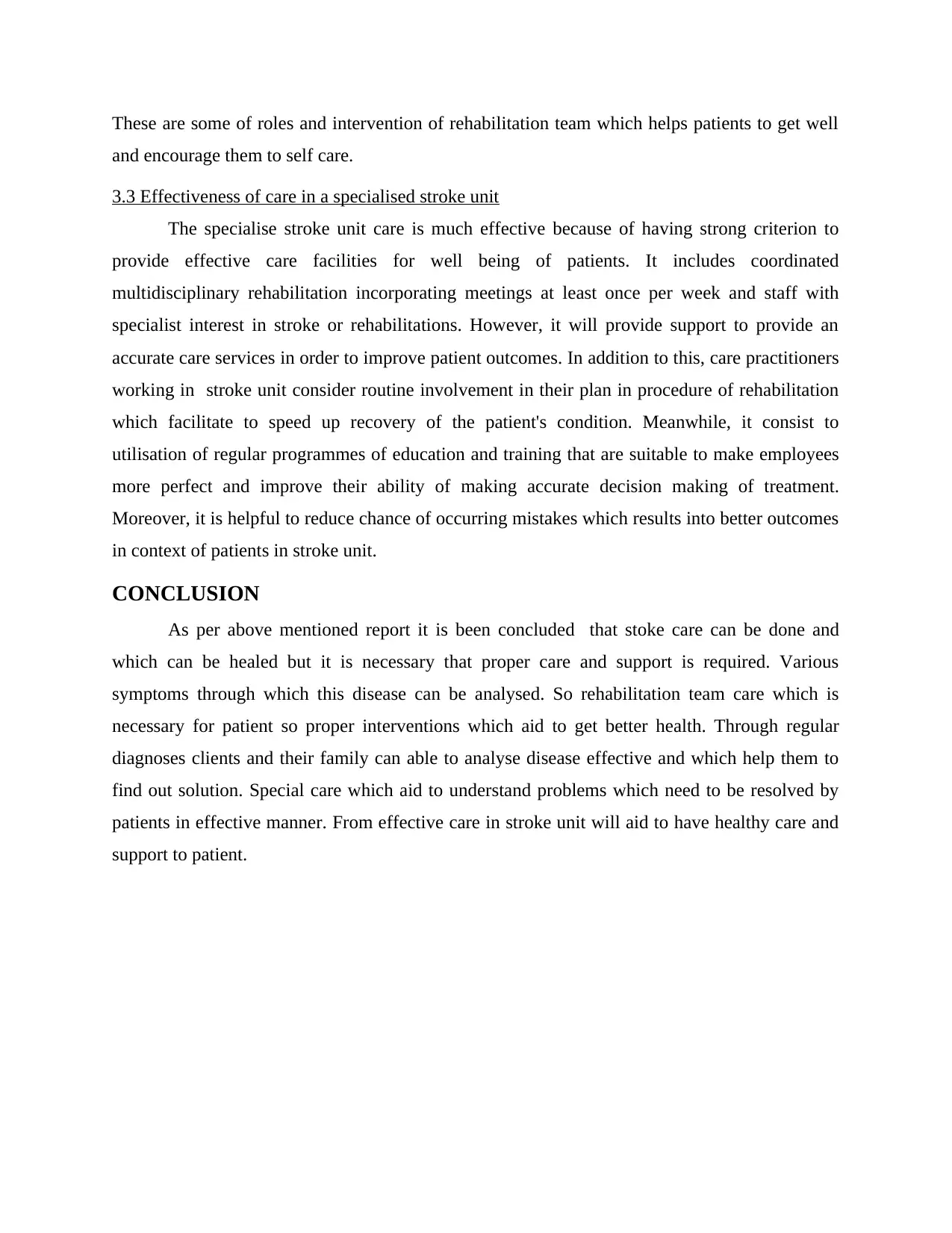
These are some of roles and intervention of rehabilitation team which helps patients to get well
and encourage them to self care.
3.3 Effectiveness of care in a specialised stroke unit
The specialise stroke unit care is much effective because of having strong criterion to
provide effective care facilities for well being of patients. It includes coordinated
multidisciplinary rehabilitation incorporating meetings at least once per week and staff with
specialist interest in stroke or rehabilitations. However, it will provide support to provide an
accurate care services in order to improve patient outcomes. In addition to this, care practitioners
working in stroke unit consider routine involvement in their plan in procedure of rehabilitation
which facilitate to speed up recovery of the patient's condition. Meanwhile, it consist to
utilisation of regular programmes of education and training that are suitable to make employees
more perfect and improve their ability of making accurate decision making of treatment.
Moreover, it is helpful to reduce chance of occurring mistakes which results into better outcomes
in context of patients in stroke unit.
CONCLUSION
As per above mentioned report it is been concluded that stoke care can be done and
which can be healed but it is necessary that proper care and support is required. Various
symptoms through which this disease can be analysed. So rehabilitation team care which is
necessary for patient so proper interventions which aid to get better health. Through regular
diagnoses clients and their family can able to analyse disease effective and which help them to
find out solution. Special care which aid to understand problems which need to be resolved by
patients in effective manner. From effective care in stroke unit will aid to have healthy care and
support to patient.
and encourage them to self care.
3.3 Effectiveness of care in a specialised stroke unit
The specialise stroke unit care is much effective because of having strong criterion to
provide effective care facilities for well being of patients. It includes coordinated
multidisciplinary rehabilitation incorporating meetings at least once per week and staff with
specialist interest in stroke or rehabilitations. However, it will provide support to provide an
accurate care services in order to improve patient outcomes. In addition to this, care practitioners
working in stroke unit consider routine involvement in their plan in procedure of rehabilitation
which facilitate to speed up recovery of the patient's condition. Meanwhile, it consist to
utilisation of regular programmes of education and training that are suitable to make employees
more perfect and improve their ability of making accurate decision making of treatment.
Moreover, it is helpful to reduce chance of occurring mistakes which results into better outcomes
in context of patients in stroke unit.
CONCLUSION
As per above mentioned report it is been concluded that stoke care can be done and
which can be healed but it is necessary that proper care and support is required. Various
symptoms through which this disease can be analysed. So rehabilitation team care which is
necessary for patient so proper interventions which aid to get better health. Through regular
diagnoses clients and their family can able to analyse disease effective and which help them to
find out solution. Special care which aid to understand problems which need to be resolved by
patients in effective manner. From effective care in stroke unit will aid to have healthy care and
support to patient.
Paraphrase This Document
Need a fresh take? Get an instant paraphrase of this document with our AI Paraphraser
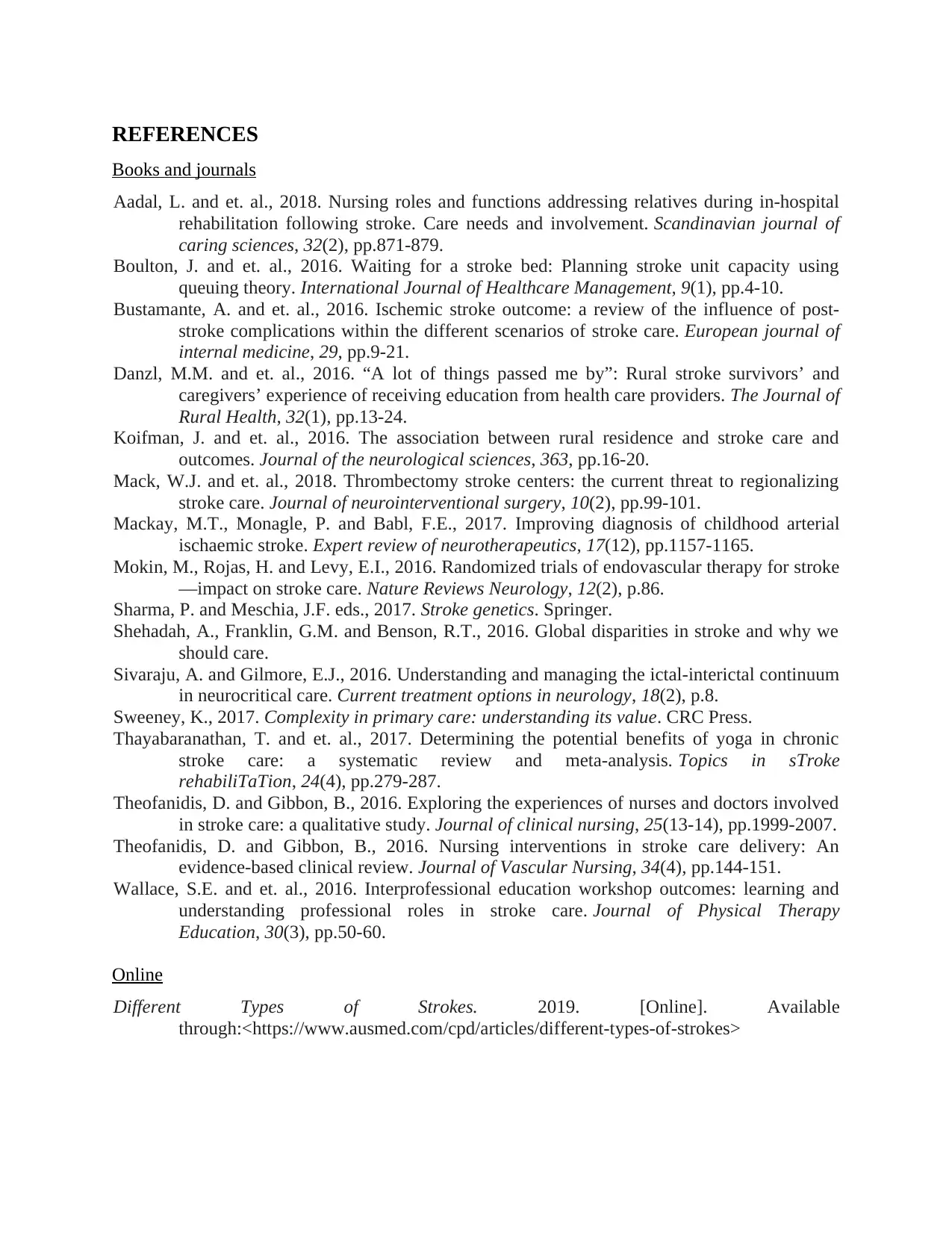
REFERENCES
Books and journals
Aadal, L. and et. al., 2018. Nursing roles and functions addressing relatives during in‐hospital
rehabilitation following stroke. Care needs and involvement. Scandinavian journal of
caring sciences, 32(2), pp.871-879.
Boulton, J. and et. al., 2016. Waiting for a stroke bed: Planning stroke unit capacity using
queuing theory. International Journal of Healthcare Management, 9(1), pp.4-10.
Bustamante, A. and et. al., 2016. Ischemic stroke outcome: a review of the influence of post-
stroke complications within the different scenarios of stroke care. European journal of
internal medicine, 29, pp.9-21.
Danzl, M.M. and et. al., 2016. “A lot of things passed me by”: Rural stroke survivors’ and
caregivers’ experience of receiving education from health care providers. The Journal of
Rural Health, 32(1), pp.13-24.
Koifman, J. and et. al., 2016. The association between rural residence and stroke care and
outcomes. Journal of the neurological sciences, 363, pp.16-20.
Mack, W.J. and et. al., 2018. Thrombectomy stroke centers: the current threat to regionalizing
stroke care. Journal of neurointerventional surgery, 10(2), pp.99-101.
Mackay, M.T., Monagle, P. and Babl, F.E., 2017. Improving diagnosis of childhood arterial
ischaemic stroke. Expert review of neurotherapeutics, 17(12), pp.1157-1165.
Mokin, M., Rojas, H. and Levy, E.I., 2016. Randomized trials of endovascular therapy for stroke
—impact on stroke care. Nature Reviews Neurology, 12(2), p.86.
Sharma, P. and Meschia, J.F. eds., 2017. Stroke genetics. Springer.
Shehadah, A., Franklin, G.M. and Benson, R.T., 2016. Global disparities in stroke and why we
should care.
Sivaraju, A. and Gilmore, E.J., 2016. Understanding and managing the ictal-interictal continuum
in neurocritical care. Current treatment options in neurology, 18(2), p.8.
Sweeney, K., 2017. Complexity in primary care: understanding its value. CRC Press.
Thayabaranathan, T. and et. al., 2017. Determining the potential benefits of yoga in chronic
stroke care: a systematic review and meta-analysis. Topics in sTroke
rehabiliTaTion, 24(4), pp.279-287.
Theofanidis, D. and Gibbon, B., 2016. Exploring the experiences of nurses and doctors involved
in stroke care: a qualitative study. Journal of clinical nursing, 25(13-14), pp.1999-2007.
Theofanidis, D. and Gibbon, B., 2016. Nursing interventions in stroke care delivery: An
evidence-based clinical review. Journal of Vascular Nursing, 34(4), pp.144-151.
Wallace, S.E. and et. al., 2016. Interprofessional education workshop outcomes: learning and
understanding professional roles in stroke care. Journal of Physical Therapy
Education, 30(3), pp.50-60.
Online
Different Types of Strokes. 2019. [Online]. Available
through:<https://www.ausmed.com/cpd/articles/different-types-of-strokes>
Books and journals
Aadal, L. and et. al., 2018. Nursing roles and functions addressing relatives during in‐hospital
rehabilitation following stroke. Care needs and involvement. Scandinavian journal of
caring sciences, 32(2), pp.871-879.
Boulton, J. and et. al., 2016. Waiting for a stroke bed: Planning stroke unit capacity using
queuing theory. International Journal of Healthcare Management, 9(1), pp.4-10.
Bustamante, A. and et. al., 2016. Ischemic stroke outcome: a review of the influence of post-
stroke complications within the different scenarios of stroke care. European journal of
internal medicine, 29, pp.9-21.
Danzl, M.M. and et. al., 2016. “A lot of things passed me by”: Rural stroke survivors’ and
caregivers’ experience of receiving education from health care providers. The Journal of
Rural Health, 32(1), pp.13-24.
Koifman, J. and et. al., 2016. The association between rural residence and stroke care and
outcomes. Journal of the neurological sciences, 363, pp.16-20.
Mack, W.J. and et. al., 2018. Thrombectomy stroke centers: the current threat to regionalizing
stroke care. Journal of neurointerventional surgery, 10(2), pp.99-101.
Mackay, M.T., Monagle, P. and Babl, F.E., 2017. Improving diagnosis of childhood arterial
ischaemic stroke. Expert review of neurotherapeutics, 17(12), pp.1157-1165.
Mokin, M., Rojas, H. and Levy, E.I., 2016. Randomized trials of endovascular therapy for stroke
—impact on stroke care. Nature Reviews Neurology, 12(2), p.86.
Sharma, P. and Meschia, J.F. eds., 2017. Stroke genetics. Springer.
Shehadah, A., Franklin, G.M. and Benson, R.T., 2016. Global disparities in stroke and why we
should care.
Sivaraju, A. and Gilmore, E.J., 2016. Understanding and managing the ictal-interictal continuum
in neurocritical care. Current treatment options in neurology, 18(2), p.8.
Sweeney, K., 2017. Complexity in primary care: understanding its value. CRC Press.
Thayabaranathan, T. and et. al., 2017. Determining the potential benefits of yoga in chronic
stroke care: a systematic review and meta-analysis. Topics in sTroke
rehabiliTaTion, 24(4), pp.279-287.
Theofanidis, D. and Gibbon, B., 2016. Exploring the experiences of nurses and doctors involved
in stroke care: a qualitative study. Journal of clinical nursing, 25(13-14), pp.1999-2007.
Theofanidis, D. and Gibbon, B., 2016. Nursing interventions in stroke care delivery: An
evidence-based clinical review. Journal of Vascular Nursing, 34(4), pp.144-151.
Wallace, S.E. and et. al., 2016. Interprofessional education workshop outcomes: learning and
understanding professional roles in stroke care. Journal of Physical Therapy
Education, 30(3), pp.50-60.
Online
Different Types of Strokes. 2019. [Online]. Available
through:<https://www.ausmed.com/cpd/articles/different-types-of-strokes>
1 out of 14
Related Documents
Your All-in-One AI-Powered Toolkit for Academic Success.
+13062052269
info@desklib.com
Available 24*7 on WhatsApp / Email
![[object Object]](/_next/static/media/star-bottom.7253800d.svg)
Unlock your academic potential
© 2024 | Zucol Services PVT LTD | All rights reserved.





